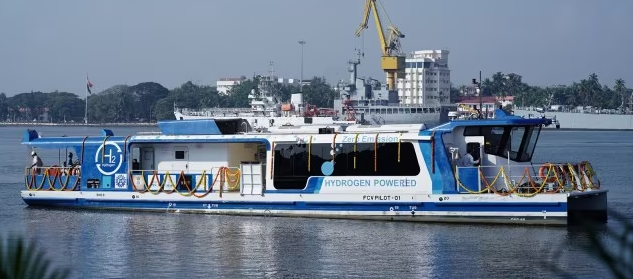ForumIAS announcing GS Foundation Program for UPSC CSE 2025-26 from 19 April. Click Here for more information.
ForumIAS Answer Writing Focus Group (AWFG) for Mains 2024 commencing from 24th June 2024. The Entrance Test for the program will be held on 28th April 2024 at 9 AM. To know more about the program visit: https://forumias.com/blog/awfg2024
Source-This post on India’s first indigenously developed hydrogen fuel cell ferry is based on the article “PM Modi launches hydrogen-powered ferry: features, significance” published in “The Indian Express” on 1st March 2024.
Why in the News?
Prime Minster recently launched India’s first indigenously developed hydrogen fuel cell ferry. It was manufactured by the Cochin Shipyard Limited (CSL) under the Harit Nauka initiative.
What are its key features?

1. Design– It is a 24-meter catamaran which can accommodate 50 people in its air-conditioned passenger area. The accommodation is made of high-quality fiberglass reinforced plastic, resembling metro train coaches.
2. Propulsion– This boat uses a 50-kilowatt PEM (proton-exchange membrane) fuel cell along with Lithium-Ion Phosphate batteries. PEM fuel cells have the advantage of quickly adjusting their output to match power demands.
3. Energy Source– This boat has five hydrogen cylinders that hold 40kg of hydrogen, providing support for eight hours of operations. Additionally, the vessel is equipped with a 3-kilowatt solar panel.
Note– A hydrogen fuel cell creates electricity using the chemical energy in hydrogen and only emits pure water, without releasing pollutants.
4. Indigenous components– CSL developed the vessel automation system and power management system. The hydrogen fuel cell system was developed by KPIT Technologies, Pune, in collaboration with the Council of Scientific and Industrial Research Labs.
5. Significance:
a. Environment Friendly– It produces zero emissions or noise, and it is energy-efficient. It will also make urban mobility smooth and easy.
b. Low maintenance cost– Since it has no moving parts, the ferry needs less maintenance than combustion vessels.
| Harit Nauka Initiative: 1. In January 2024, the shipping ministry unveiled the Harit Nauka guidelines for inland vessels. 2. According to the guidelines, all states must aim to use green fuels for 50% of inland waterways passenger fleets within the next decade and 100% by 2045. 3. This aims to cut greenhouse gas emissions according to the Maritime Amrit Kaal Vision 2047. |
UPSC Syllabus- Science & Technology




